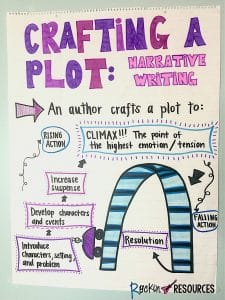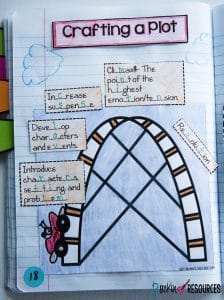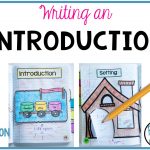Do you need ideas for teaching plot to a narrative story? A plot is the events that organize and make up a story. When planning a plot for a story, consider the narrative elements of characters, setting, problem of the story, character development, suspense, climax, and solution. Crafting a plot takes planning! These ideas are ideal for any writing curriculum and are a part of a series of mini lessons for writer’s workshop designed for scaffolding through the writing process.
How do you teach students an effective way to craft a plot?
1. Teach
Use an anchor chart using a roller coaster to show how to plot out the events of a story.
2. Mentor Text
I like to use Cinderella to teach plot. My favorite version is by Sarah L. Thomson.
Read the story to your class and have a student use a toy car to roll up and down the roller coaster poster. Help the student along by showing that the author does a fabulous job increasing the suspense again and again throughout the story (getting to the ball, dancing, clock strikes midnight, running away, losing her shoe). Then the climax of the story would be when the prince is placing the shoe on her foot. My students were so stinkin cute because they got excited along with me when we reach the top of the coaster even though they’ve heard the story a million times. We even held our hands up in the air like we are on the coaster as we read the rest of the story. Cute, huh? Anything to get them excited about learning!
3. Model
Take the story you are working on as a class and model a plan for the plot of the story. Talk out loud as you brainstorm and have students chime in.
4. Take Notes
Have students take notes on plot so they have a reference next time they are developing a narrative story. If your time is limited, make a copy of an anchor chart or the notes you want them to remember and hand it out to your students to keep in a notebook. This is an example of an interactive notebook page for notes. If you don’t have my interactive writing notebooks, you can have your students draw a roller coaster and write in the notes. Then ask students to draw arrows up and down the coaster to show the direction of movement. The student sample below forgot the arrows. Oopsie!
1. Introduce characters, setting, and problem.
2. Develop characters and events.
3. Increase suspense.
4. Climax!! The point of the highest emotion/tension.
5. Resolution
5. Apply
Now students have the foundation for writing a good plot for their own story. Have them go back to their prompt and create a plot using all 5 parts of the roller coaster!
6. Share
Students get excited to share their ideas. It may also help a few reluctant writers who needed a little push!
I hope you gained some ideas for your plot lesson and had fun riding the coaster!
Check out my FREE writing masterclass! CLICK HERE
LAST LESSON: WRITING MINI LESSON #14: USING GRAPHIC ORGANIZERS
NEXT LESSON: WRITING MINI LESSON #16- WRITING AN INTRODUCTION FOR A NARRATIVE ESSAY!
CLICK HERE FOR THE FULL LIST OF WRITING MINI LESSONS
This lesson is also included in the STEP-BY-STEP WRITING® Programwith mini-lessons designed to scaffold through the writing process. Writing units included are sentence structure, paragraph writing, narrative writing, opinion writing, and informative writing. See what is included in the image below and click on it to learn more about them! You will turn your reluctant writers into ROCKSTAR WRITERS™!
“My grade level used this last year and our state assessment scores improved greatly in writing!!! Other grades are using your units! I am soooo excited to see what the kiddos remember from year to year since it spirals. It’s helped them TONS and with our population, we always struggle to find successful resources. We love them!!!” – Megan








